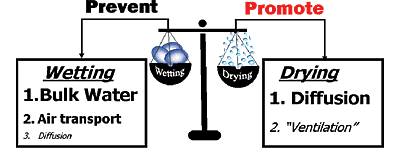Moisture Management in Wall Assemblies: Air, Water, and Vapor Barriers
Moisture Management Principles And The Choice Of Barriers
Moisture problems occur if buildings get wet and stay wet, because they are unable to dry. According to building scientist Joe Lstiburek, Ph.D., P.E., "moisture problems are fundamentally rate issues: moisture accumulation occurs if the wetting rate exceeds the drying rate." Consequently, moisture management must include strategies to manage the balance between wetting and drying, that is, to prevent wetting and promote drying.
The balance of wetting and drying, main sources
and mechanisms |
 |
The main moisture sources, bulk water, air transport, and diffusion, do not have an equal contribution to wetting. In order of their contributions, these sources are bulk or rain water infiltration, which is usually the largest moisture source for above-grade walls; air transported moisture, which could contribute up to 200 times more moisture than water vapor diffusion; and water vapor diffusion, which has the smallest contribution to wetting, when compared to the other two sources.
In order to prevent wetting, it is essential to protect against the main moisture sources, bulk water (with a water-resistant barrier) and water vapor transported by air currents (with an air barrier). In addition, it is recommended to protect against moisture transported by diffusion (with a vapor barrier), as long as the use of a vapor barrier does not interfere with the wall drying ability.
The potential drying mechanisms in buildings include drainage of incidental water to the outside, controlled ventilation (not to be confused with uncontrolled air leakage through the building envelope), and vapor diffusion.
For example, a continuous drainage plane is an effective strategy for removing incidental bulk water, and a ventilated air space behind the cladding can reduce the moisture content in the air space outside the sheathing and facilitate drying. However, in order for ventilation drying to be effective, it is still necessary for water vapor to be able to diffuse from the envelope into the ventilated space. Given the importance of vapor diffusion as a drying mechanism, it is critical that a diffusion pathway is considered.
Wall design is important because the arrangement of building envelope elements influences the conditions within the wall, and therefore the environment under which the materials must function.
For walls with insulation inside the stud cavity, the main temperature gradient occurs across the interior wall cavity, over the thermal insulation. As a result, in heating climates, temperatures towards the exterior of the insulated cavity could drop below the dew point temperature creating conditions that could lead to interstitial condensation. In a cooling climate, the cooler surfaces would be towards the inside. In order to avoid persistent wetting, the wall must have diffusion open pathways, to allow diffusion drying. This wall design relies on diffusion drying for incidental moisture management.
For the exterior rigid insulation wall design, the main temperature gradient occurs across the exterior insulation, outside the interior wall cavity. As a result, the dew point temperature is moved outside the wall cavity, reducing the potential for condensation. This wall design is more robust and less sensitive to condensation, and does not rely on vapor diffusion for drying.









